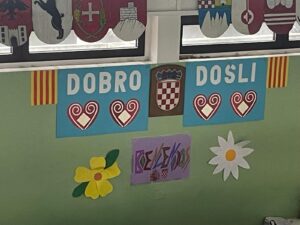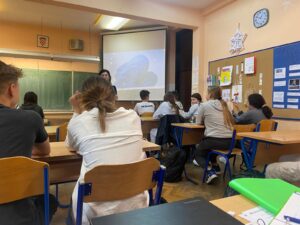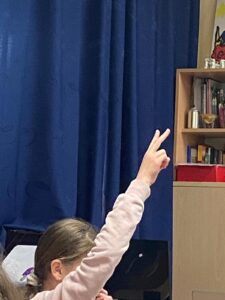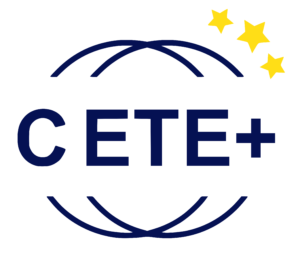 Avui 25 d’abril hem estat rebuts a l’escola Snova Skola Rudes als afores de Zagreb, on ens esperava la Sanja per presentar-nos a la directora de l’escola, i fer-nos l’acompanyament durant el matí.
Avui 25 d’abril hem estat rebuts a l’escola Snova Skola Rudes als afores de Zagreb, on ens esperava la Sanja per presentar-nos a la directora de l’escola, i fer-nos l’acompanyament durant el matí.
Today, April 25, we were received at the Snova Skola Rudes school on the outskirts of Zagreb, where Sanja was waiting for us to introduce us to the school principal and accompany us during the morning.
Ens han rebut amb un gran mural a l’entrada de l’escola amb el missatge de benvinguda en croat, la senyera i un “Bienvenidos”.

We were greeted with a large mural at the entrance of the school with the welcome message in Croatian, the sign and a “Bienvenidos”.
Ens hem reunit amb un grup de mestres, entre les que hi havia la mestra encarregada del projecte de ràdio. En aquesta primera reunió, i després d’haver fet les presentacions pertinents, hem resolt dubtes a nivell d’organització dels claustre, horari de l’escola, procedència dels alumnes, nombre d’alumnes … El que ens ha cridat més l’atenció és el fet que tot i que hem vist una escola molt gran i amb grans espais, l’horari que segueixen els alumnes el tenen dividit en 2 franges: El alumnes amb cursos senars aquesta setmana venen al matí, mentre que els que fan cursos parells fan horari de tarda. La setmana vinent alternaran l’ordre. L’horari de matí comença aproximadament a les 8 del matí (tot i que a partir de les 7.15 tenen activitats extraescolars) i acaba cap a les 13.10. L’horari de tarda comença a les 13.15 i acaba a les 18.20 (amb una hora d’extraescolars fins a les 19.10).
We met with a group of teachers, including the teacher in charge of the radio project. In this first meeting, and after having made the relevant presentations, we resolved doubts regarding the organization of the cloisters, school hours, the origin of the students, the number of students… What appealed to us the most attention is the fact that although we have seen a very large school with large spaces, the schedule followed by the students is divided into 2 bands: The students with odd courses this week come in the morning, while those who even courses have an afternoon  schedule. Next week they will alternate the order. The morning schedule starts at approximately 8am (although they have extracurricular activities from 7.15am) and ends around 1.10pm. The afternoon schedule starts at 1:15 p.m. and ends at 6:20 p.m. (with an after-school hour until 7:10 p.m.).
schedule. Next week they will alternate the order. The morning schedule starts at approximately 8am (although they have extracurricular activities from 7.15am) and ends around 1.10pm. The afternoon schedule starts at 1:15 p.m. and ends at 6:20 p.m. (with an after-school hour until 7:10 p.m.).
Els alumnes fan 3 àpats a l’escola, l’esmorzar el tenen totalment subvencionat per l’estat, la majoria també dinen a l’escola i cap a les 13.30 fan un petit àpat de fruita i un snak de xocolata. Disposen de 2 tipus de fruita a l’entrada del menjador que poden consumir sempre que vulguin.
The students have 3 meals at school, breakfast is fully subsidized by the state, most also have lunch at school and around 1.30pm they have a small meal of fruit and a chocolate snack. They have 2 types of fruit at the entrance to the dining room that they can eat whenever they want.
Tot i ser una escola de primària, l’alumnat a partir de 5è i fins a 8è, no disposa d’una única aula de referència sinó que van d’una aula a l’altra i es la mestra la que sempre està a la mateixa aula. Ens ha sorprès la gran quantitat de llibres que tenen i que porten a les motxilles. No treballen amb dispositius mòbils, ni ordinadors ni tauletes, i la
l’altra i es la mestra la que sempre està a la mateixa aula. Ens ha sorprès la gran quantitat de llibres que tenen i que porten a les motxilles. No treballen amb dispositius mòbils, ni ordinadors ni tauletes, i la mestra recull els mòbils en una caixa així que comença la classe.
mestra recull els mòbils en una caixa així que comença la classe.
Despite being a primary school, the students from 5th to 8th grade do not have a single reference classroom but go from one classroom to another and it is the teacher who is always there same classroom We were surprised by the large number of books they have and carry in their backpacks. They don’t work with mobile devices, computers or tablets, and the teacher collects the mobiles in a box so the class starts.
Les aules estan ben equipades amb ordinadors, pantalles deplegables i projectors, però les pissarres són de guix. Les taules són de 2 en 2 i majoritàriament orientades mirant cap a la pissarra. El fet de ser taules de 2 permet poca flexibilitat d’agrupaments. Les aules són grans i lluminoses i decorades amb tasques artístiques de l’alumnat.
The classrooms are well equipped with computers, roll-up screens and projectors, but the blackboards are made of chalk. The tables are 2 by 2 and mostly oriented facing the board. The fact that there are tables of 2 allows little flexibility of groupings. The classrooms are large and bright and decorated with the students’ artistic works.
Durant les classes hi ha silenci, un gran respecte capa la tasca dels altres i cap tipus d’interrupció del discurs de la mestra. Les classes més participatives es fan seguint un ordre escrupulós de demanda de torn de paraula que es fa aixecant la mà amb 2 dits amunt. El respecte es respira en tot moment a les aules i als passadissos, respecte entre els iguals i cap a les mestres. Salutacions a l’entrar i sortir de les aules, salutacions quan algú entra a l’aula, … L’ambient de treball és absolutament adient per poder treballar i ens ha sorprès gratament el fet que ho fan de la manera més natural. En les sessions d’un dia sencer, des de les 8 del matí a les 5 de la tarda, només hem vist que una mestra hagi hagut de cridar l’atenció a un alumne per mal comportament. I en aquest cas no era per comportament disruptiu, sinó per no estar fent la tasca. Val a dir també que tot i que les mestres ens han dit que tenen alumnes amb necessitats educatives especials a les aules no hem vist cap tipus d’adaptació curricular ni hem detectat cap necessitat greu.
During classes there is silence, great respect for the work of others and no interruption of the teacher’s speech. The most participative classes are held following a scrupulous order of demand for a turn to speak which is done by raising the hand with 2 fingers up. Respect is breathed at all times in the classrooms and in the corridors, respect between equals and towards the teachers. Greetings when entering and leaving the classrooms, greetings when someone enters the classroom, … The working environment is absolutely suitable for working and we were pleasantly surprised by the fact that they do it in the most natural way. In the sessions of a whole day, from 8 in the morning to 5 in the afternoon, we have only seen that a teacher had to draw attention to a student for bad behaviour. And in this case it was not for disruptive behavior, but for not doing the task. It is also worth saying that although the teachers have told us that they have students with special educational needs in the classrooms, we have not seen any type of curricular adaptation nor have we detected any serious needs.
A les sessions d’avui hem assistit a classes en què s’han treballat qüestions relatives al Media Litercy.
In today’s sessions, we attended classes in which issues relating to Media Literacy.
 Hem conegut una ràdio escolar que porta més de 20 anys en funcionament. Després de la primera visita a les aules del centre, ens hem dirigit a un petit espai situat a la primera planta del centre. En aquest espai ens esperaven una dotzena d’alumnes preparats per fer la gravació del seu programa de ràdio. La docent responsable d’aquesta tasca ens explicat que barregen alumnes de diferents edats i els més grans són els encarregats de tutoritzar els infants més petits. Aquests alumnes més grans aprofiten per donar consells de com utilitzar correctament les eines i si cal donar les correccions indicacions necessàries. En cas que fos necessari, la docent també realitzar les correccions que pertoquin.
Hem conegut una ràdio escolar que porta més de 20 anys en funcionament. Després de la primera visita a les aules del centre, ens hem dirigit a un petit espai situat a la primera planta del centre. En aquest espai ens esperaven una dotzena d’alumnes preparats per fer la gravació del seu programa de ràdio. La docent responsable d’aquesta tasca ens explicat que barregen alumnes de diferents edats i els més grans són els encarregats de tutoritzar els infants més petits. Aquests alumnes més grans aprofiten per donar consells de com utilitzar correctament les eines i si cal donar les correccions indicacions necessàries. En cas que fos necessari, la docent també realitzar les correccions que pertoquin.
We met a school radio that has been in operation for more than 20 years. After the first visit to the center’s classrooms, we headed to a small space located on the center’s first floor. In this space, a dozen students were waiting for us, ready to record their radio program. The teacher responsible for this task explained to us that they mix students of different ages and the older ones are in charge of tutoring the younger children. These older students take the opportunity to give advice on how to use the tools correctly and, if necessary, give the necessary corrections. If necessary, the teacher will also make the appropriate corrections.
Un cop realitzada l’entrevista a unes companyes de sisè, ha sigut el nostre torn. Les alumnes ens han convidat a seure a la cadira dels entrevistats i ens han realitzat un seguit de preguntes relacionades amb la nostra estada al seu país. La majoria de l’entrevista s’ha dut a terme en anglès però també ens han demanat si podíem parlar en Català o en castellà.
Once the interview was done with some sixth grade classmates, it was our turn. The students invited us to sit in the chairs of the interviewees and asked us a series of questions related to our stay in their country. Most of the interview was conducted in English but we were also asked if we could speak in Catalan or Spanish.
En acabar l’entrevista, ens han ensenyat tots els recursos que fan servir: micròfon, programa d’edició, ordinador,…
At the end of the interview, they showed us all the resources they use: microphone, editing program, computer,…
A més també ens han ensenyat el primer vídeo que van crear el seu programa de televisió ara fa 20 anys i que va aconseguir un premi a nivell nacional.
In addition, they also showed us the first video they created for their TV show 20 years ago, which won a national award.





